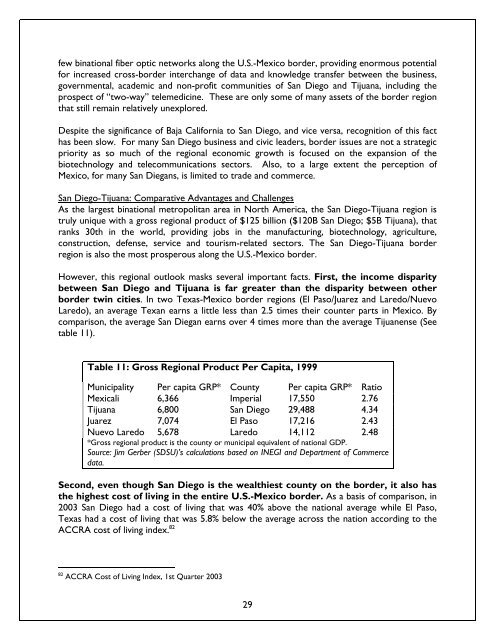Blurred Borders - International Community Foundation
Blurred Borders - International Community Foundation
Blurred Borders - International Community Foundation
You also want an ePaper? Increase the reach of your titles
YUMPU automatically turns print PDFs into web optimized ePapers that Google loves.
few binational fiber optic networks along the U.S.-Mexico border, providing enormous potential<br />
for increased cross-border interchange of data and knowledge transfer between the business,<br />
governmental, academic and non-profit communities of San Diego and Tijuana, including the<br />
prospect of “two-way” telemedicine. These are only some of many assets of the border region<br />
that still remain relatively unexplored.<br />
Despite the significance of Baja California to San Diego, and vice versa, recognition of this fact<br />
has been slow. For many San Diego business and civic leaders, border issues are not a strategic<br />
priority as so much of the regional economic growth is focused on the expansion of the<br />
biotechnology and telecommunications sectors. Also, to a large extent the perception of<br />
Mexico, for many San Diegans, is limited to trade and commerce.<br />
San Diego-Tijuana: Comparative Advantages and Challenges<br />
As the largest binational metropolitan area in North America, the San Diego-Tijuana region is<br />
truly unique with a gross regional product of $125 billion ($120B San Diego; $5B Tijuana), that<br />
ranks 30th in the world, providing jobs in the manufacturing, biotechnology, agriculture,<br />
construction, defense, service and tourism-related sectors. The San Diego-Tijuana border<br />
region is also the most prosperous along the U.S.-Mexico border.<br />
However, this regional outlook masks several important facts. First, the income disparity<br />
between San Diego and Tijuana is far greater than the disparity between other<br />
border twin cities. In two Texas-Mexico border regions (El Paso/Juarez and Laredo/Nuevo<br />
Laredo), an average Texan earns a little less than 2.5 times their counter parts in Mexico. By<br />
comparison, the average San Diegan earns over 4 times more than the average Tijuanense (See<br />
table 11).<br />
Table 11: Gross Regional Product Per Capita, 1999<br />
Municipality Per capita GRP* County Per capita GRP* Ratio<br />
Mexicali 6,366 Imperial 17,550 2.76<br />
Tijuana 6,800 San Diego 29,488 4.34<br />
Juarez 7,074 El Paso 17,216 2.43<br />
Nuevo Laredo 5,678 Laredo 14,112 2.48<br />
*Gross regional product is the county or municipal equivalent of national GDP.<br />
Source: Jim Gerber (SDSU)’s calculations based on INEGI and Department of Commerce<br />
data.<br />
Second, even though San Diego is the wealthiest county on the border, it also has<br />
the highest cost of living in the entire U.S.-Mexico border. As a basis of comparison, in<br />
2003 San Diego had a cost of living that was 40% above the national average while El Paso,<br />
Texas had a cost of living that was 5.8% below the average across the nation according to the<br />
ACCRA cost of living index. 82<br />
82 ACCRA Cost of Living Index, 1st Quarter 2003<br />
29















